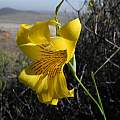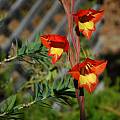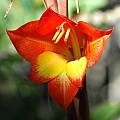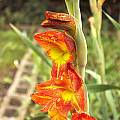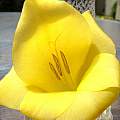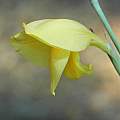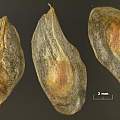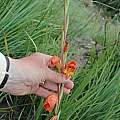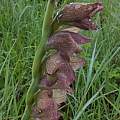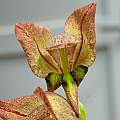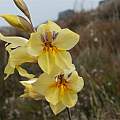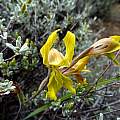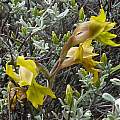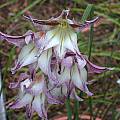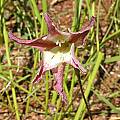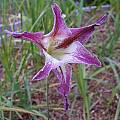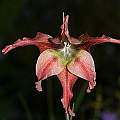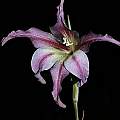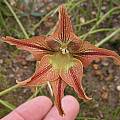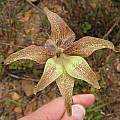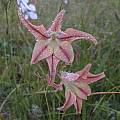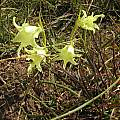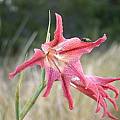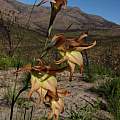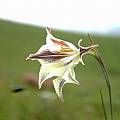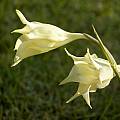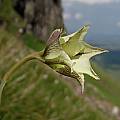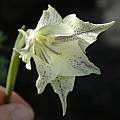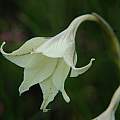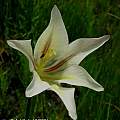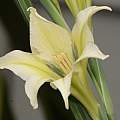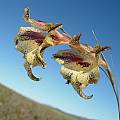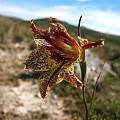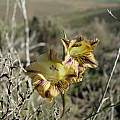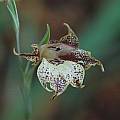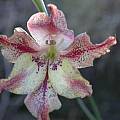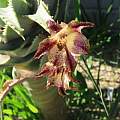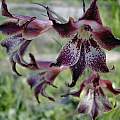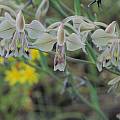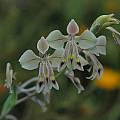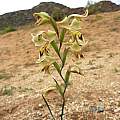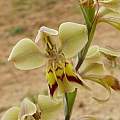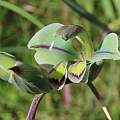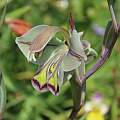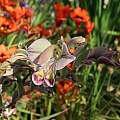Yellow may not be the first color that comes in mind thinking of Gladiolus, but there are some very striking species in this category. Quite often, there is a secondary yellow form of mainly orange or purple Gladiolus species.
Page 1: G. alatus... Page 3: G. pardalinus... Page 4: G. woodii...
Gladiolus comptonii G.J.Lewis is a rare plant that grows on rocky sandstone slopes in the northwest Cape in a localized area on Heerenlogement Mountain at the northwestern end of the Olifants River Mountains. Plants grow 45 to 60 cm high. The leaves are linear and the few bright yellow short tubed flowers have brown streaks on the lower tepals. This species flowers mid to late July (winter). Photo taken by Rachel Saunders.
Gladiolus dalenii Van Geel is a widespread and common species found not only in Southern Africa, but also in other parts of tropical Africa. It has been known by a number of names over the years; there have been 27 synonyms for the tropical Africa and Madagascar forms and 14 more for the southern African forms. The main synonyms for the southern Africa collections have been Gladiolus natalensis and Gladiolus psittacinus. This species blooms at different times of the year depending on the location, but there are probably flowers every month of the year somewhere in its native habitats. Flowers are either red to orange with yellow markings on the lower half of the three lower tepals or yellow to greenish with red to brown streaks on the upper tepals. Although it favors moist habitats and is often found in grassland, it can also be found in dry habitats with only a short wet season. The ones I grew in Northern California lived for a number of years in the garden, dormant during our wet winters, appearing late spring and surviving through the dry summer and blooming in the fall. The flowering stalks were very tall with a number of flowers. Photos 1-2 of those plants were taken by Mary Sue Ittner. Photo 3 by Cameron McMaster shows plants in cultivation. Photos 4-5 by Mary Hunter and Mary Sue Ittner show the first bloom from seed of a yellow form of ssp. dalenii, once known as Gladiolus primulinus blooming in late summer in Northern California. The last photo by David Pilling shows seed.
The first photo below from Cameron McMaster shows flowering plants in habitat in the Eastern Cape. The second is another habitat shot taken near Balloch in the Eastern Cape, January 2010 by Bob Rutemoeller. Photo Nr. 3 from Rachel Saunders shows an unusual color form and was taken in northern KwaZulu-Natal in January 2015. The last photo shows the beautiful detail on likely the same color form, as the seeds were obtained from Silverhill, flowering the second year from seed for Martin Bohnet.
Gladiolus delpierrei Goldblatt grows on marshy sandstone slopes at 1200 m in the Cederberg Mountains. Growing from 40-45 cm high and blooming December to January, it has yellowish cream flowers with yellow and red marking on the lower tepals. Photo taken January 2014 by Rachel Saunders.
Gladiolus karooicus Goldblatt & J.C.Manning was named in 2009. It is found from the Little Karoo to the Komsberg section of the Roggeveld Escarpment. Photos taken September 2011 by Cameron McMaster near Matjiesfontein.
Gladiolus liliaceus Houtt. grows on clay slopes over a wide area of South Africa (from the Cedarberg Mountains to Port Elizabeth) and blooms winter to spring. Growing from 30 to 80 cm high, the 1 to 4, sometimes 6, flowers are an inclined spike. The large flowers are brown, dull pinkish red, tan, purplish or cream to greenish yellow and turn bluish to mauve in the evenings when they become intensely clove scented. Depending on the location and the elevation with the lower elevations blooming earlier, this species blooms from late August to December.
The ones grown by Mary Sue Ittner have not been very fragrant and the color change is subtle. Photo 1 was taken by Mary Sue Ittner. Photos 2-3 from Bob Rutemoeller attempt to show the change in color. Photo 2 was taken during the day and photo 3 in the early evening. Andrew Harvie's photos (4-5) show the orangey red color of the day and the more purple color of the night. To ensure correct color balance both photos were taken with a flash and same exposure. He notes that he wishes he could also share the fragrance.
The forms pictured below in the first four photos were all found at Drayton and were blooming August-September 2003. Photos by Bob Rutemoeller including a single yellow one. The fifth photo is of a red flowered one photographed by Cameron McMaster near Bredasdorp in the Overberg. The last photo from the book Plants of the Klein Karoo courtesy of Jan and Anne Lise Schutte-Vlok.
Gladiolus longicollis Baker is a species found in a wide area of southern Africa, including the southern Cape, the eastern Cape, the Free State and the Northern Province. It has pale yellow to white long tubed flowers that are either uniformly colored or mottled with brown. Flowers are night blooming and sweetly scented of carnation and cloves. There are two subspecies:
Gladiolus longicollis ssp. longicollis has a shorter perianth tube and transparent upper tepals and flowers October to November. It is found from Oudtshoorn in the Western Cape through the Eastern Cape and Free State and into Lesotho and Gauteng where it usually grows on moist, south facing slopes in low grassy fynbos or rocky grassland.
Gladiolus longicollis ssp. platypetalus (Baker) Goldblatt & J.C.Manning has a longer perianth tube and broader petals with the outer whorl tepals longer than the inner whorl and grows in rocky grasslands from central KwaZulu-Natal to Mpumalanga and Limpopo. Its flowering season extends into January and possibly February.
The first three photos from Cameron McMaster and the next two from Mary Sue Ittner. Photos three thru five were taken at Naude's Nek.
The first photo from the book Plants of the Klein Karoo courtesy of Jan and Anne Lise Schutte-Vlok. They describe it as growing up to 60 cm tall with narrow cylindrical leaves and flowers with red brown spots and lines. The anthers are not much exposed, a characteristic that helps distinguish it from a similar looking Gladiolus tristis. The second photo is from Arnold Trachtenberg.
Gladiolus maculatus Sweet extends across the southern coast and immediate interior of the winter rainfall area to the Eastern Cape where it is often found growing in heavy soils in renosterveld. Flowers are dull yellow to lilac and speckled with brown or purplish spots. They are long-tubed and fragrant during the day and the evening. The first three pictures were taken by Cameron McMaster near Napier and Bredasdorp in the Overberg.
The first two pictures below are of garden flowers taken by Mary Sue Ittner December 2007 and January 2009. The next two were taken by Alan Horstmann and the last by Dirk Wallace.
Gladiolus orchidiflorus Andrews is found on clay and sandstone soils from Namibia to Cape Flats and also to Free State and flowers in the spring. It has linear to sword-shaped leaves that are thickened in the midline. Flowers are in a 5 to 12 flowered spike, windowed in profile, greenish to purple with dark purple markings on the lower tepals, and are very fragrant. Photos 1-2 are habitat shots taken in Namaqualand by Bob Rutemoeller and Mary Sue Ittner September 2006. Photos 3-4 were taken near Carolusberg, Namaqualand by Cameron McMaster September 2011.
The photos below were taken by Alan Horstmann.
Page 1: G. alatus... Page 3: G. pardalinus... Page 4: G. woodii...
